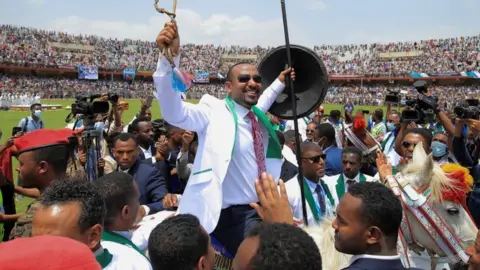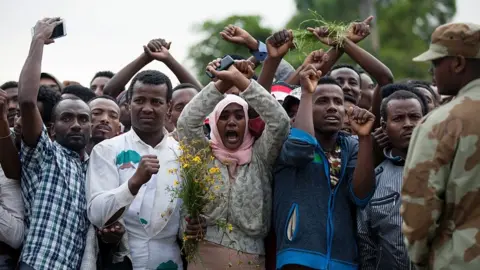

 AFPThousands of people have died since November in the war in Tigray
AFPThousands of people have died since November in the war in Tigray
A conflict between the government of Ethiopia and forces in its northern Tigray region has thrown the country into turmoil.
Fighting has been going on since November 2020, destabilising the populous country in the Horn of Africa, leaving thousands of people dead with 350,000 others living in famine conditions.

Eritrean soldiers are also fighting in Tigray for the Ethiopian the government. All sides have been accused of atrocities.
A power struggle, an election and a push for political reform are among several factors that led to the crisis.
In simple chunks of 100, 300 and 500 words – we explain how and why the war started.


The conflict started on 4 November, when Ethiopian Prime Minister Abiy Ahmed ordered a military offensive against regional forces in Tigray.
He said he did so in response to an attack on a military base housing government troops.
The escalation came after months of feuding between Mr Abiy’s government and leaders of Tigray’s dominant political party.
For almost three decades, the party was at the centre of power, before it was sidelined by Mr Abiy, who took office in 2018 after anti-government protests.
Mr Abiy pursued reforms, but when Tigray resisted, the political crisis erupted into war.


The roots of this crisis can be traced to Ethiopia’s system of government.
Since 1994, Ethiopia has had a federal system in which different ethnic groups control the affairs of 10 regions.
Remember that powerful party from Tigray? Well, this party – the Tigray People’s Liberation Front (TPLF) – was influential in setting up this system.
It was the leader of a four-party coalition that governed Ethiopia from 1991, when a military regime was ousted from power.

 ReutersPrime Minister Abiy Ahmed, who won the Nobel Peace Prize in 2019, has made sweeping political reforms
ReutersPrime Minister Abiy Ahmed, who won the Nobel Peace Prize in 2019, has made sweeping political reforms
Under the coalition, Ethiopia became more prosperous and stable, but concerns were routinely raised about human rights and the level of democracy.
Eventually, discontent morphed into protest, leading to a government reshuffle that saw Mr Abiy appointed prime minister.
Mr Abiy liberalised politics, set up a new party (the Prosperity Party), and removed key Tigrayan government leaders accused of corruption and repression.
Meanwhile, Mr Abiy ended a long-standing territorial dispute with neighbouring Eritrea, earning him a Nobel Peace Prize in 2019.
These moves won Mr Abiy popular acclaim, but caused unease among critics in Tigray.
Tigray’s leaders saw Mr Abiy’s reforms as an attempt to centralise power and destroy Ethiopia’s federal system.
The feud came to a head in September, when Tigray defied the central government to hold its own regional election. The central government, which had postponed national elections because of coronavirus, said it was illegal.


The rift grew when the central government suspended funding for Tigray and cut ties with it in October. At the time, Tigray’s administration said this amounted to a “declaration of war”.
Tensions increased, and the eventual catalyst came when Tigrayan forces were accused of attacking army bases to steal weapons.
Mr Abiy said Tigray had crossed a “red line”.
“The federal government is therefore forced into a military confrontation,” he said.


Ethiopia, Africa’s oldest independent country, has undergone sweeping changes since Mr Abiy came to power.
A member of the Oromo, Ethiopia’s largest ethnic group, Mr Abiy made appeals to political reform, unity and reconciliation in his first speech as prime minister.
His agenda was spurred by the demands of protesters who felt Ethiopia’s political elite had obstructed a transition to democracy.

 AFPSeveral years of protests led to the resignation of Mr Abiy’s predecessor
AFPSeveral years of protests led to the resignation of Mr Abiy’s predecessor
For more than two decades the political scene had been dominated by a coalition of four ethnically-based parties – with Tigrayans, who make up around 7% of the population, holding sway.
In the 1970s and 1980s their party, the TPLF, fought a war to seize control of the government from a military junta. The party succeeded, which is how it came to be the leading member of the coalition government that took power in 1991.
The coalition gave autonomy to Ethiopia’s regions, but retained a tight grip on the central government, with critics accusing it of repressing political opposition.
So Mr Abiy dissolved the coalition in 2019 – but the TPLF refused to join his new Prosperity Party.
This snub was followed by further escalations.
Tigray’s decision to hold its own election last September, for example, was an unprecedented act of defiance against the central government.
Both sides then designated each other as “illegitimate”.
Tigray argued, at the time, that the central government had not been tested in a national election since Mr Abiy’s appointment as prime minister. Polls have since been held in some parts of the country.
The TPLF also called out the prime minister for his “unprincipled” friendship with Eritrean President Isaias Afwerki, who has since sent troops to support Mr Abiy in Tigray.
There has long been animosity between Tigray and Eritrea’s government.
A dispute over territory along their shared border was the cause of a war fought between Ethiopia and Eritrea from 1998 until 2000.
You may remember this dispute making headlines in 2018.
That year, Mr Abiy signed a peace treaty with Eritrea, ending the territorial spat.
A year later, Mr Abiy won the Nobel Peace Prize. But now it is war and starvation that is drawing attention to Ethiopia.


More on the Tigray crisis:


More than two million of Tigray’s six million people have fled their homes since 4 November, when Mr Abiy ordered an invasion after the TPLF fighters captured federal military bases.
Tens of thousands of them have sought refuge in neighbouring Sudan.
Tens of thousands of people fled to Sudan when the conflict erupted
The TPLF has been designated a terrorist organisation. Resistance fighters have formed the Tigray Defence Forces (TDF), incorporating both TPLF and non-TPLF members.
With the communications largely cut in Tigray, the exact number of casualties is not clear and aid workers have been unable to access areas.
According to researchers at Belgium’s University of Ghent, there have been at least 10,000 reported deaths and 230 massacres.
As Africa’s second-most populous country, Ethiopia is pivotal to stability in the Horn of Africa.
There is also a concern that the conflict could further exacerbate ethnic tensions and could lead to the break-up of the country.






GIPHY App Key not set. Please check settings